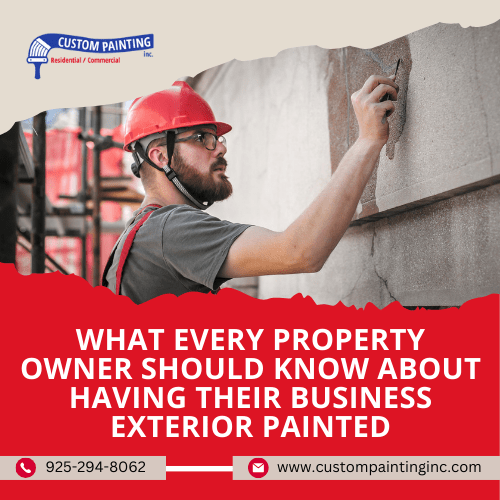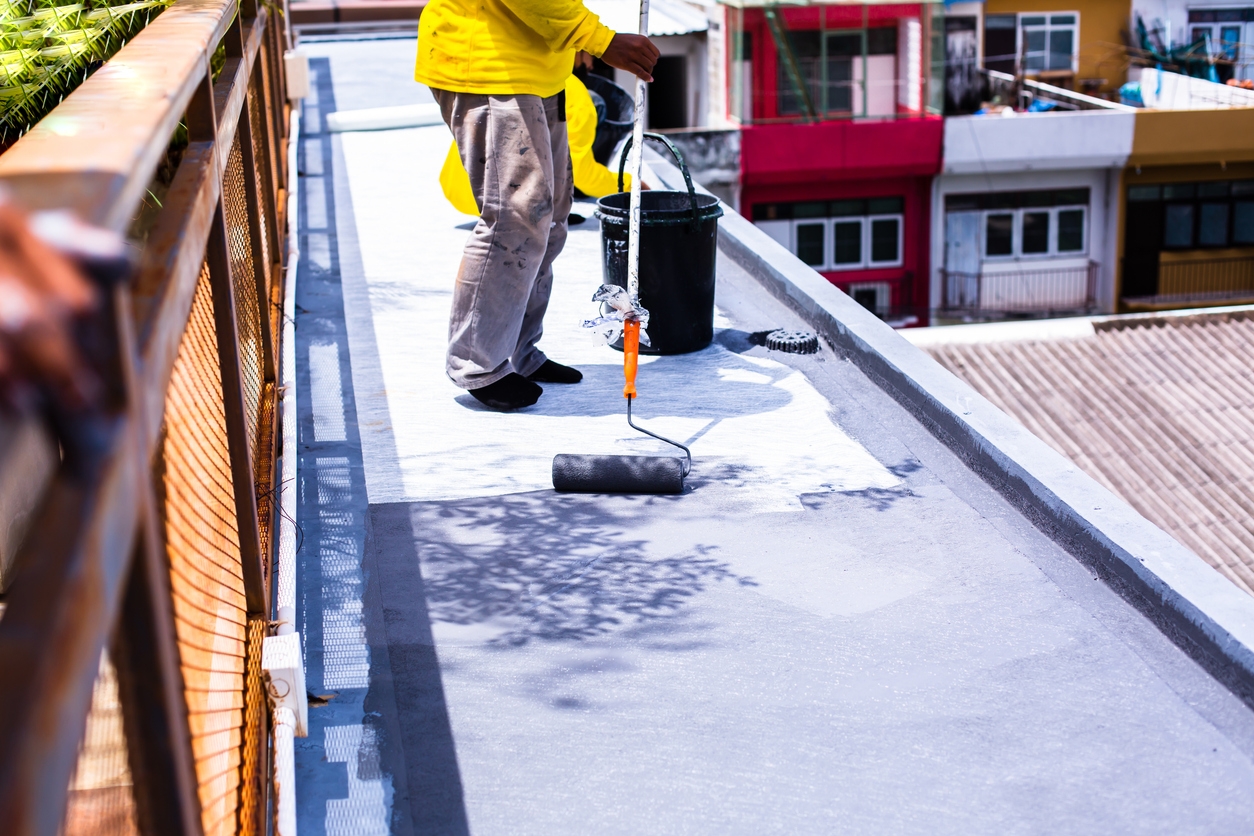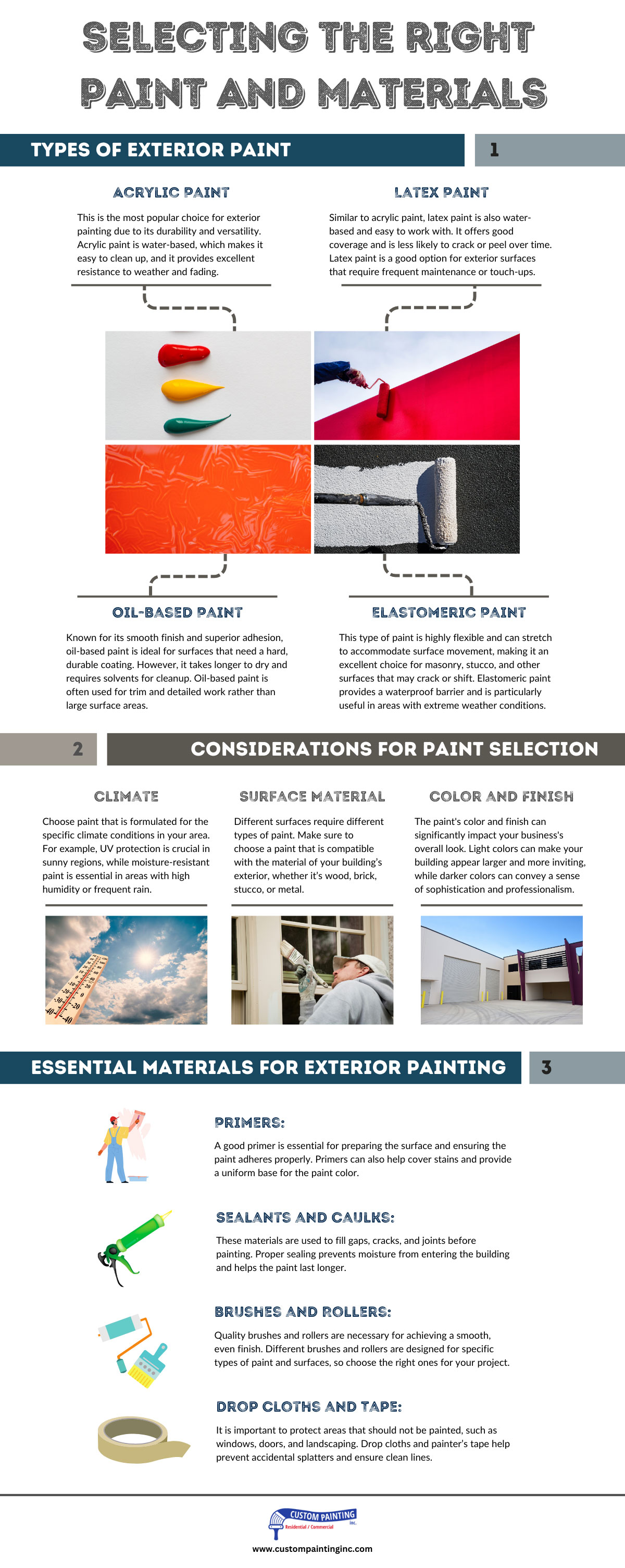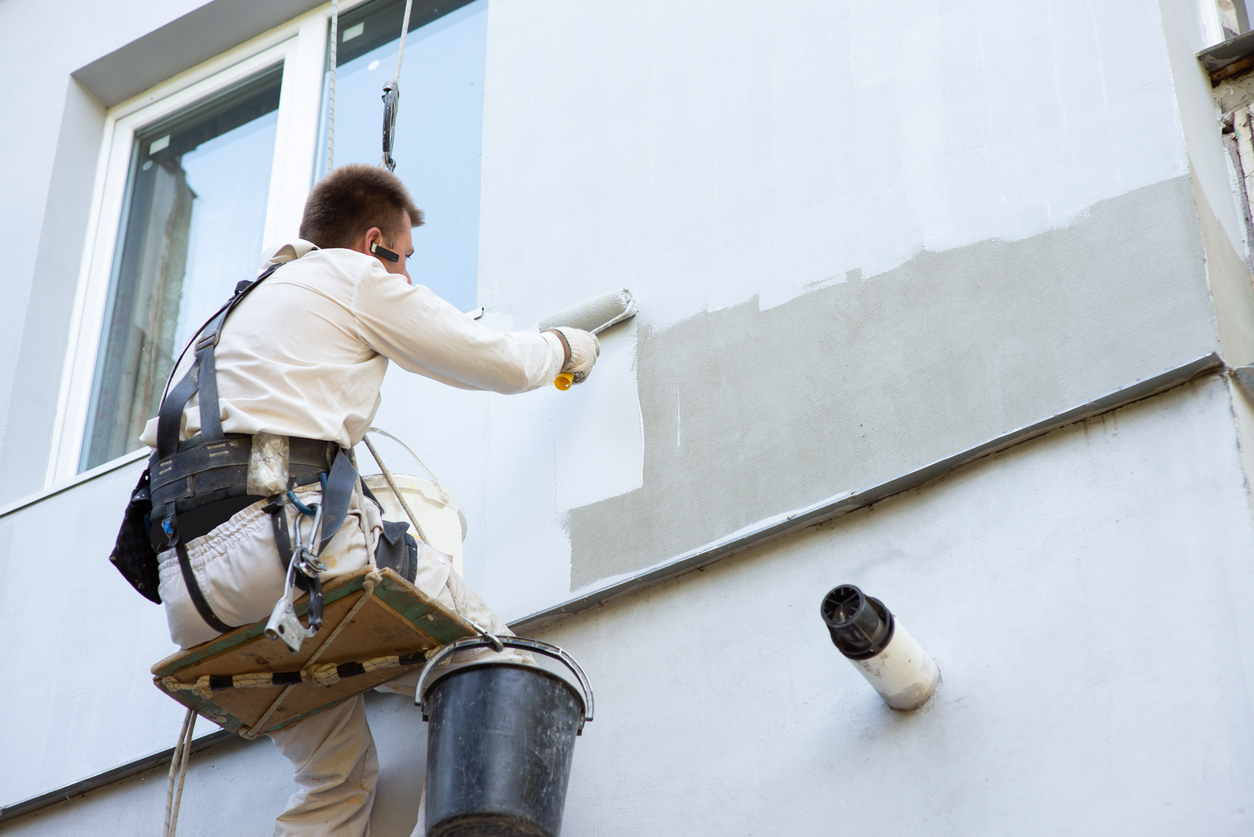A well-maintained Concord, CA area business exterior is vital to your company’s success. A clean and freshly painted façade can significantly enhance your brand’s image, as your business’s exterior is the first impression customers have. As part of this process you may also need to have an old awning removed, wood rot repaired and more. In this article, we’ll look at the essential aspects every property owner needs to know about having their business exterior painted.
We will tackle the different benefits of exterior painting. Whether you want to refresh your business’s look or maintain its structural integrity, understanding the importance and advantages of exterior painting is crucial for any property owner.
Reasons to Paint Your Business Exterior

Here are several compelling reasons to consider painting your business exterior:
Enhance Curb Appeal
First impressions are crucial for any Walnut Creek area business. A well-painted exterior can instantly make your business look more inviting and professional. When potential customers see a well-maintained building, they are more likely to perceive your business as trustworthy and reliable. This enhanced curb appeal can attract new customers and create a positive image in the community.
Protect Against Weather and Environmental Damage
Your Benicia, CA business exterior is constantly exposed to harsh weather conditions like rain, snow, wind, and UV rays. Over time, these elements can cause significant damage to the building’s structure and appearance. A high-quality paint job acts as a protective barrier, shielding your property from moisture, temperature changes, and other environmental factors. This protection can extend the lifespan of your building and reduce maintenance costs.
Increase Property Value
Investing in a professional paint job for your Vallejo, CA area business can significantly increase the value of your property. Whether you plan to sell in the near future or not, maintaining the exterior of your building is a smart financial decision. Potential buyers and investors are more likely to be attracted to a well-cared-for property, making it easier to negotiate a higher selling price.
Boost Employee Morale
A pleasant and visually appealing work environment can have a positive impact on employee morale. When your business exterior looks clean and attractive, it creates a sense of pride among employees. This, in turn, can lead to increased productivity and a more positive workplace atmosphere. Employees are likely to feel more motivated and satisfied working in a well-maintained building.
Stand Out from Competitors
In a competitive market like Antioch, CA, making your business stand out is important. A distinctive and well-painted exterior can set your business apart from neighboring properties and competitors. Unique color schemes or branding elements incorporated into the paint job can help reinforce your brand identity and make your business more memorable to customers.
Compliance with Regulations
In some areas, local regulations and guidelines require property owners to maintain the exterior appearance of their buildings. Regular painting can help ensure your business complies with these standards, avoiding potential fines and penalties. Staying up to date with maintenance keeps you in good standing with local authorities and demonstrates your commitment to the community.
Cost-Effective Marketing
A beautifully painted exterior can serve as a cost-effective marketing tool. Passersby and potential customers will likely notice a vibrant, well-maintained building. This increased visibility can translate into more foot traffic and, ultimately, more business. In essence, your building’s exterior becomes a form of advertising that works around the clock.
Choosing the Right Time for Painting
Deciding when to paint the exterior of your business is crucial to ensure a high-quality finish and minimal disruption to your operations. Here are some key factors to consider when planning your painting project:
Best Seasons and Weather Conditions for Exterior Painting
The success of an exterior paint job heavily depends on the weather conditions during the painting process. Generally, the best time to paint your business exterior is during mild, dry weather. Here’s a closer look at the optimal seasons for painting:
- Spring and Fall typically offer the most favorable conditions for exterior painting. Temperatures are moderate, and humidity levels are lower, providing an ideal environment for paint to dry and cure properly.
- Summer: While summer can be a good time for painting, it’s essential to avoid extremely hot days. High temperatures can cause paint to dry too quickly, leading to uneven application and potential cracking. Early mornings or late afternoons are often the best times to paint during summer.
- Avoiding Rainy and Humid Conditions: Painting in wet or humid conditions can cause paint to blister and peel. Choosing a dry period with no rain in the forecast is crucial for at least 24-48 hours after application. Humidity can also affect drying, so selecting a period with low humidity is advisable.
Considerations Regarding Business Hours and Minimizing Disruption
Maintaining smooth business operations while painting your exterior requires careful planning for any Lafayette, CA area business. Here are some strategies to minimize disruption:
- Scheduling During Off-Hours: Consider scheduling the painting project during off-peak hours or when your business is closed. Early mornings, evenings, weekends, or holidays can be ideal times to carry out the work without interfering with regular business activities. This approach minimizes the impact on customers and employees.
- Phased Approach: A phased approach might be necessary if your business operates around the clock or cannot close for painting. Break the project into smaller sections and complete them one at a time. This method allows parts of the building to remain accessible while others are painted, reducing overall disruption.
- Informing Customers and Employees: Communicate the painting schedule in advance to both employees and customers. Clear signage and notices can help manage expectations and minimize inconvenience. Providing alternative entrances or pathways can also ensure smooth operations during the painting process.
- Working with Professional Painters: Hiring experienced professional painters can make a significant difference in managing the project efficiently. Professionals are skilled at working quickly and minimizing mess, ensuring a high-quality finish with minimal disruption to your business.
Choosing the right time for painting your business exterior involves considering both the weather conditions and the operational needs of your business. Planning carefully and working with professionals can create a beautiful, long-lasting paint job for your business property.
Selecting the Right Paint and Materials
Choosing the right paint and materials for your business exterior is essential to achieve a durable and attractive finish. Here’s a guide to help you make informed decisions:
Types of Exterior Paint
Different types of exterior paint offer varying benefits, so it’s important to select the one that best suits your building’s needs:
- Acrylic Paint: This is the most popular choice for exterior painting due to its durability and versatility. Acrylic paint is water-based, which makes it easy to clean up, and it provides excellent resistance to weather and fading. It also adheres well to most surfaces, including wood, stucco, and masonry.
- Latex Paint: Similar to acrylic paint, latex paint is also water-based and easy to work with. It offers good coverage and is less likely to crack or peel over time. Latex paint is a good option for exterior surfaces that require frequent maintenance or touch-ups.
- Oil-Based Paint: Known for its smooth finish and superior adhesion, oil-based paint is ideal for surfaces that need a hard, durable coating. However, it takes longer to dry and requires solvents for cleanup. Oil-based paint is often used for trim and detailed work rather than large surface areas.
- Elastomeric Paint: This type of paint is highly flexible and can stretch to accommodate surface movement, making it an excellent choice for masonry, stucco, and other surfaces that may crack or shift. Elastomeric paint provides a waterproof barrier and is particularly useful in areas with extreme weather conditions.
Considerations for Paint Selection
When selecting paint for your business exterior, consider the following factors to ensure the best results:
- Climate: Choose paint that is formulated for the specific climate conditions in your area. For example, UV protection is crucial in sunny regions, while moisture-resistant paint is essential in areas with high humidity or frequent rain.
- Surface Material: Different surfaces require different types of paint. Make sure to choose a paint that is compatible with the material of your building’s exterior, whether it’s wood, brick, stucco, or metal.
- Color and Finish: The paint’s color and finish can significantly impact your business’s overall look. Light colors can make your building appear larger and more inviting, while darker colors can convey a sense of sophistication and professionalism. The finish (e.g., matte, satin, gloss) also affects the appearance and maintenance of the paint. Glossy finishes are easier to clean but may highlight imperfections, while matte finishes can hide flaws but are harder to maintain.
Essential Materials for Exterior Painting
In addition to selecting the right paint, using high-quality materials and tools is crucial for a successful exterior painting project:
- Primers: A good primer is essential for preparing the surface and ensuring the paint adheres properly. Primers can also help cover stains and provide a uniform base for the paint color.
- Sealants and Caulks: These materials are used to fill gaps, cracks, and joints before painting. Proper sealing prevents moisture from entering the building and helps the paint last longer.
- Brushes and Rollers: Quality brushes and rollers are necessary for achieving a smooth, even finish. Different brushes and rollers are designed for specific types of paint and surfaces, so choose the right ones for your project.
- Drop Cloths and Tape: It is important to protect areas that should not be painted, such as windows, doors, and landscaping. Drop cloths and painter’s tape help prevent accidental splatters and ensure clean lines.
Hiring Professional Painters vs. DIY
Each approach has advantages and disadvantages. Understanding these can help you decide what’s best for your business needs and capabilities.
Hiring Professional Painters
Pros:
- Expertise and Quality: Professional painters have the skills and experience to deliver a high-quality finish. They are knowledgeable about the best techniques, materials, and products for different surfaces and conditions.
- Time Efficiency: Professionals can complete the job more quickly and efficiently than an inexperienced person. This minimizes downtime and disruption to your business operations.
- Safety: Exterior painting can be hazardous, especially for multi-story buildings. Professionals are trained in safety protocols and have the necessary equipment to handle high and difficult-to-reach areas safely.
- Warranty and Insurance: Many professional painting companies offer warranties on their work and are insured. This provides peace of mind, knowing that any issues that arise will be addressed without additional costs.
- Comprehensive Service: Professionals handle all aspects of the job, from surface preparation and priming to cleanup and final inspection. This ensures a thorough and consistent result.
Cons:
- Cost: Hiring professional painters can be more expensive than doing it yourself. However, the investment often pays off in terms of quality and longevity.
- Less Control: While professionals will consult with you on colors and finishes, you may have less direct control over the process than you would with a DIY project.
Doing It Yourself (DIY)
Pros:
- Cost Savings: The most significant advantage of a DIY approach is the potential cost savings. You can save on labor costs and only pay for materials and tools.
- Control and Flexibility: DIY allows you to have complete control over the project. You can work at your own pace and make changes as you go.
- Satisfaction: Completing a project yourself can be highly rewarding and provide a sense of accomplishment.
Cons:
- Time-Consuming: DIY painting can be very time-consuming, especially if you lack experience. The preparation, painting, and cleanup can take much longer than expected.
- Quality and Durability: Without a professional’s expertise, the paint job’s quality may suffer. Mistakes can lead to uneven finishes, drips, and peeling paint, which may require redoing the work sooner than anticipated.
- Safety Risks: Painting the exterior of a building, particularly a multi-story one, can be dangerous. Without proper safety equipment and training, ladders, scaffolding, and high surfaces pose significant risks.
- Limited Knowledge: Understanding the best materials and techniques for different surfaces and weather conditions can be challenging. Material selection or application mistakes can lead to subpar results and reduced paint lifespan.
Assessing What’s Best for Your Business Needs and Capabilities
To determine whether hiring professional painters or undertaking a DIY project is best for your business, consider the following factors:
- Budget: Assess your budget to see if you can afford professional services. While DIY may seem cheaper initially, consider the potential costs of mistakes and the value of your time.
- Time: Evaluate how much time you or your staff can realistically dedicate to the project. If time is limited, hiring professionals can ensure the job is done quickly and efficiently.
- Skill Level: Be honest about your painting skills and experience. If you lack confidence or experience, professional painters can provide a superior finish and ensure the job is done correctly.
- Project Scope: Consider the size and complexity of the project. Large, multi-story buildings or those with intricate details are better suited for professional painters.
- Safety: Assess the safety risks involved in your project. If the building is tall or has difficult-to-reach areas, prioritize safety by hiring professionals.
- Long-Term Value: Think about the long-term value of a high-quality paint job. Professional work may have a higher upfront cost but can save money in the long run by lasting longer and reducing maintenance needs.
Understanding Costs and Budgeting
Understanding the factors that influence the cost and tips for budgeting can help you manage expenses effectively and avoid unexpected costs.
Factors That Influence the Cost of Exterior Painting
Several factors can affect the overall cost of painting your business exterior. Being aware of these can help you plan and budget more accurately:
- Size of the Building: Larger buildings require more paint and labor, increasing the overall cost. The surface area that needs to be painted is one of the primary determinants of the price.
- Surface Material: Different materials (e.g., wood, stucco, brick, metal) require different types of paint and preparation. Some surfaces may need more extensive prep work, such as scraping, sanding, or priming, which can add to the cost.
- Condition of the Surface: The existing condition of the building’s exterior can impact the cost. Surfaces that are damaged, dirty, or have peeling paint may require more preparation and repair before painting begins.
- Quality of Paint and Materials: Higher-quality paints and materials generally cost more but can offer better durability and a longer-lasting finish. Investing in quality products can be cost-effective in the long run.
- Labor Costs: Labor costs can vary based on the complexity of the job, the experience of the painters, and the region where your business is located. Professional painters with a strong reputation and high skill levels may charge more, but their expertise can ensure a better outcome.
- Access and Safety Requirements: If your building is tall or has hard-to-reach areas, additional equipment such as scaffolding or lifts may be required, adding to the cost. Ensuring worker safety can also impact the budget.
- Weather Conditions: Optimal weather conditions are crucial for exterior painting. Delays due to unfavorable weather can extend the project timeline and increase costs, particularly if rescheduling or additional labor is needed.
Tips for Budgeting and Avoiding Unexpected Expenses
Proper budgeting can help you manage costs and avoid surprises during your exterior painting project. Here are some tips to ensure you stay on track:
- Get Multiple Quotes: Obtain detailed quotes from several professional painting contractors. This allows you to compare prices and services, ensuring you get the best value for your money.
- Set a Realistic Budget: Consider all potential costs, including labor, materials, preparation, and cleanup. Factor in a contingency fund of about 10-15% of the total budget to cover unexpected expenses.
- Plan for Surface Preparation: Address any necessary repairs or cleaning before painting begins. Proper surface preparation is crucial for a long-lasting paint job and can prevent costly issues down the line.
- Choose Quality Materials: While it might be tempting to cut costs by selecting cheaper materials, investing in high-quality paint and supplies can save money in the long term by reducing the need for frequent touch-ups and repainting.
- Schedule Wisely: Plan your painting project during favorable weather conditions to avoid delays and additional costs. Spring and fall are typically the best seasons for exterior painting due to milder temperatures and lower humidity.
- Clarify the Scope of Work: Ensure the contract with your painter includes all aspects of the job, such as preparation, priming, painting, and cleanup. A clear scope of work can prevent misunderstandings and additional charges.
- Communicate Clearly: Maintain open communication with your contractor throughout the project. Regular updates and discussions can address any issues promptly and keep the project on track.
- Monitor the Project: Monitor the progress and quality of the work being done. Addressing any concerns early can prevent more significant problems and expenses later.
Legal and Compliance Considerations
It’s essential to be aware of the legal and compliance considerations that can impact your project.
Necessary Permits and Regulations for Exterior Painting
Before starting your exterior painting project, you may need to obtain certain permits and adhere to specific regulations. Here are some key points to consider:
- Permits: Some municipalities require permits for exterior painting, especially if significant changes or repairs are involved. Check with your local building department to determine if a permit is needed. Permit requirements can vary based on the size and scope of the project.
- Historical Buildings: If your business is located in a historical district or the building itself is designated as a historical landmark, additional regulations and approvals may be required. These rules are in place to preserve the property’s historical integrity.
- HOA Guidelines: If your business is part of a Homeowners Association (HOA) or a commercial property management organization, there may be specific guidelines and approval processes for exterior changes. Review these guidelines to ensure compliance.
- Signage and Advertising: If your painting project includes the addition of logos, signage, or advertisements, you may need additional permits. Local sign ordinances often regulate the size, placement, and type of signage allowed.
Ensuring Compliance with Local Zoning and Environmental Laws
Compliance with local zoning and environmental laws is crucial for a successful and lawful exterior painting project. Here are some aspects to consider:
1. Zoning Regulations: Local zoning laws may dictate the types of colors and finishes you can use on your building’s exterior. These regulations often aim to maintain a cohesive aesthetic in certain areas, such as residential neighborhoods or commercial districts. Check with your local zoning office to understand any restrictions or requirements.
2. Environmental Regulations: Environmental laws regulate the use of certain paints and materials that may contain harmful chemicals. Here are some key considerations:
- Volatile Organic Compounds (VOCs): Many jurisdictions have strict regulations on the use of paints containing VOCs, which can contribute to air pollution and pose health risks. Choose low-VOC or zero-VOC paints to ensure compliance and promote a healthier environment.
- Disposal of Hazardous Materials: Proper disposal of paint and related materials is essential to avoid environmental contamination. Follow local guidelines for hazardous waste disposal to prevent legal issues and protect the environment.
- Lead Paint: If your building was constructed before 1978, lead-based paint may be present. Federal and state regulations require specific safety measures for disturbing lead paint, including certification and proper containment. Hire certified professionals to handle lead paint safely and comply with the law.
Best Practices for Legal and Compliance Adherence
To ensure your exterior painting project adheres to all legal and compliance requirements, consider the following best practices:
- Research and Plan: Begin by researching local regulations and requirements. Contact your local building department, zoning office, and environmental agencies to gather all necessary information.
- Hire Licensed Professionals: Working with licensed and insured painting contractors can help ensure compliance with local laws and regulations. Professionals are often familiar with permitting processes and environmental standards.
- Document Everything: Keep thorough records of permits, approvals, and communications with local authorities. This documentation can be invaluable if any issues arise during or after the project.
- Communicate with Stakeholders: Inform neighbors, tenants, and relevant stakeholders about your painting project and any potential disruptions. Good communication can help prevent misunderstandings and complaints.
- Monitor and Inspect: Regularly monitor the project to ensure all work complies with the necessary permits and regulations. Conduct inspections at key stages to verify adherence to environmental and safety standards.
Conclusion
Painting the exterior of your business is a valuable investment that can enhance curb appeal, protect your property, and increase its value. By understanding the reasons to paint, selecting the right time and materials, and considering whether to hire professionals or do it yourself, you can make informed decisions for a successful project. Awareness of legal and compliance considerations will ensure your project runs smoothly and lawfully.
Ready to transform your business exterior? Contact Custom Painting, Inc. today at 925-686-0903 or fill out our contact form. Let our experienced team help you achieve a beautiful and long-lasting finish for your property.





